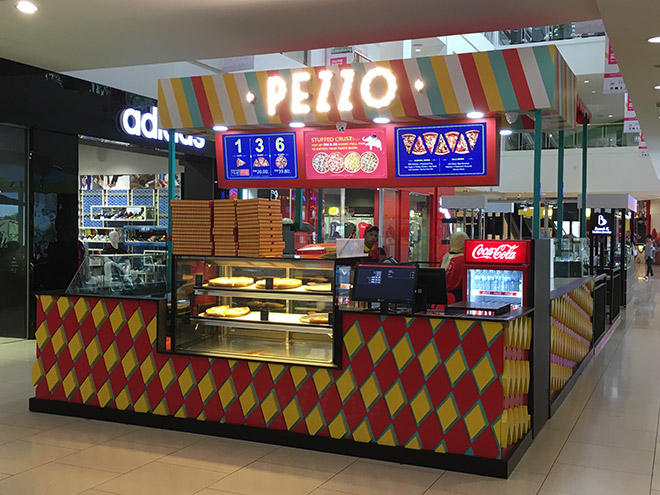 Many Sarawakians are likely to know the brand “Sugarbun” – a household name popular here for its broasted chicken, children’s parties and other fast food offerings.
Many Sarawakians are likely to know the brand “Sugarbun” – a household name popular here for its broasted chicken, children’s parties and other fast food offerings.
Back when the company was predominantly in the fast food business, Borneo Oil Bhd (BornOil) was originally listed in 1997 as Sugarbun Corporation Bhd.
BornOil’s SugarBun franchise outlets, Sarawak’s very own home grown brand, is loved by many over the years, enticing locals with its signature dishes and offerings from an innovative menu.
Today, BornOil has evolved into a business group with what it views as key core businesses critical to survival and profitability.
It branched out into gold which carries real value and a precious metal that shall re-emerge one day as a tried and tested benchmark of valuation, oil – with a focus on biofuel, real property yield, and food.
According to executive director Raymond Teo Kiew Leong, from the name Sugarbun, the group changed its name to BornOil since January 2007 after a reverse takeover and change in direction with deeper focus on these four areas.
“That said, we also continued with our fast food legacy as it’s been hugely successful and continues to give us strong cash flow,” he shared with BizHive Weekly.
In its quarterly report on consolidated results for the third quarter ended October 31, 2015, BornOil said that the group performed well as envisaged during the quarter.
“The fast food division continued to perform remarkably well. In addition to the contribution from its existing fast food outlets, the opening of the new Pezzo franchise chain has further contributed to the overall turnover.
“The mining, energy and related division also performed satisfactorily while the other divisions performed as expected,” the group added.
Teo highlighted that during the past two decades, BornOil has transformed its operations in an effort to maximize value for shareholders and today, the group operates in four segments.
They are restaurants, franchising and head office operations segment, general trading segment, management and operations of properties segment, and oil, gas and energy related businesses segment.
The company’s subsidiaries include SB Resorts Sdn Bhd, which provides management services, catering services, operates cafe and entertainment and rental of equipment; L&V Trading Sdn Bhd, which is engaged in food processing and sales and distribution of equipment and spare parts; Borneo Oil & Gas Corporation Sdn Bhd, which is engaged in oil, gas and energy and its related business; SB Partners Sdn Bhd, which is engaged in investment holding and SB Franchise Management Sdn Bhd, which is engaged in the provision of management and marketing services.
“We are exploring exploring new and innovative ways to reward our shareholders, many who have stood with us through thick and thin and, at this stage, we are mulling various value and proposals for them to further realise greater value in the company,” Teo said.
Cashing in on the gold rush
Teo holds a personal view that the global currency and economic model may revisit a variation model of the Bretton Woods system during our lifetime.
Bretton Woods as defined by Financial Times Lexicon, refers to the international monetary arrangement, agreed upon by the allied nations in 1944 in Bretton Woods, US, that created the International Monetary fund (IMF) and World Bank and that set up a system of fixed exchange rates with the US dollar as the international reserve currency.
He went on to note that the gold valuation system was terminated on August 15, 1971 by the US, ending the Bretton Woods system.
“The US dollar was rendered a fiat currency and consequently recognised as a reserve currency used by many states.

“Simultaneously multiple other currencies such as the sterling pound also became free-floating,” he said.
While China was still very much a communist country back in 1971, Teo said today the nation is emerging as a global superpower in its own right and building up on its gold reserves to add greater credibility to its currency especially in respect of its ‘One Belt’ vision.
“At the end of the day, everything goes back to fundamentals – and we believe that the scarcity of gold would eventually lead to greater demand (for gold) by centrals banks to demonstrate the strengths of their economies and currencies.
“Besides China, the emergence of the other BRIC countries (Brazil, Russia and India) together with Indonesia and South Africa and the ‘borderless’ world today should see gold being a most sought after commodity in the mid to long term.
“At BornOil, we share the same philosophy – that’s why we’re building up on our gold inventory to demonstrate the strength of the BornOil Group, and that our price per share is solidly backed by this precious metal,” Teo enthused.
The gold enthusiast highlighted that the price of gold was around the US$1,240 (US$1 = RM4.23) per ounce mark, and, at the time of BornOil’s response (early March), was set for the best month in about four years.
Some industry experts are predicting that it will go even higher, he said.
“For example, Deutsche Bank has publicly stated that gold remains a buy even though it has rallied more than 16 per cent since the start of the year,” he said.
“The surge in gold prices can be attributed to a couple of current factors: China is wobbling, oil is plummeting, Britain is threatening to quit Europe, there’s stock market uncertainties the world over, and Japan is moving towards negative interest rates.
“This is because gold is often perceived as a ‘safe haven’ in such uncertain times.”
As a result, BornOil’s gold inventory has increased tremendously in value recently. Based on current gold price per ounce of US$1,240 (US$1 = RM4.23), this then translates into an inventory valued at approximately US$21.71 million or RM91.83 million.
As at Friday March 4, BornOil issued capital stands at some 2.973 billion shares, giving rise to three sen per gold backing. The group’s goal was to further increase its gold backing per share.
Last year, BornOil made the strategic decision of venturing into the gold industry and it has made the group’s fundamentals even stronger than ever before with rising gold prices.
“We are optimistic that gold prices would continue to head upwards. It is heartening to note that industry is beginning to view BornOil as proxy to the Malaysian gold industry,” Teo said.
Having said that, Teo revealed that from an operations perspective, the timing of BornOil’s entry into gold-mining could not be more ideal.
BornOil went in at a time when the ringgit was weak and the exchange rate worked in the group’s favour as direct cost of production had gone down during that period (since production is incurred in ringgit).
“The mining arrangements did not carry any acquisition cost as infrastructure and development facilities were already in place at the sites .
“As a result, BornOil saved on a great deal of capital expenditure in terms of infrastructure and pre-mining preparations,” he added.
On a side note, BornOil’s mining activities are not limited to gold, but also comprises limestone.
Teo said in a statement in BornOil’s annual report 2015 that the availability of vast limestone reserves with significant potential in various industries has made this a priority in the group’s future plans.
As for BornOil’s gas and energy-related business, the group has also been making progress on this front with a focus on biofuel. “We’re carrying out extensive research to convert biomass to oil,” Teo revealed.
Teo added that on the corporate front, BornOil is also very fortunate to have two strong and visionary substantial shareholders in Victoria Limited and the Hap Seng Group.
SugarBun: Local fast food icon is here to stay
As one of the pioneers in the fast food industry in East Malaysia since 1984, SugarBun has carved a marketing niche therein amidst international fast food franchises.
From its humble beginnings, the brand now boasts a chain of restaurants in Malaysia, Brunei, Bangladesh and Australia.
Over the years, SugarBun has witnessed and catered to the changing tastes of Malaysian, and has established itself as an icon in Sabah and Sarawak.
Through extensive brand building activities, coupled with good QSCV practice (quality, service, cleanliness and value), and offering innovative menu items, the SugarBun brand name has become synonymous with “great food and great prices”.
With a focus on product diversity that appeals to different palates, SugarBun has over the years catered to the changing taste of the consumers.
From the signature Broasted Chicken which uses only fresh chicken marinated with special ingredients and the famous Savoury Rice, SugarBun has since expanded its innovative menu to include Asian cuisines.
As such, SugarBun’s product range now includes Broasted Chicken, “Hoki” fish, Tilapia Fish with Sambal, Savoury Rice, as well as Asian cuisines (Claypot, Nasi Lemak and Satay) and beverages such as the three layer tea, Ice Kacang and Cendol.
On SugarBun’s competitive edge, Teo told the BizHive Weekly that this is clearly in the customer service experience and approach that their management team brings to the table.
In addition, Teo listed SugarBun’s core competencies, highlighting that they are evident in their menu management, operations training system management and quality control (QC)/audit management.
With a total of 69 restaurants in Sarawak, five in Sabah and 10 overseas, SugarBun racked up total sales of RM93 million in for 2014. The year 2015 saw SugarBun’s total sales increasing to RM102 million, indicating that the fast food restaurant’s performance is not slowing down anytime soon.
Moving forward, to maintain the growth of the SugarBun brand, the company has adopted several approaches to further strengthen its existing market while also exploring new markets.
One of the approaches involves expansion of the SugarBun brand to smaller towns. As the main cities is saturated with fast food restaurants and good locations are hard to come by, Teo explained that expanding to smaller cities would help to capture more market segments where competition is less intense as these markets are not well served and have yet to be tapped into by competitors.
The company has also appointed area franchisees in Sabah, Malaysia and Indonesia, an approach which Teo said has proved to be a better move to enter a new market.
“Nothing guaranteed success more than the owner who is personally committed and active in the business,” he added.
“The appointment of Area Franchisees marked the beginning of new venture into a new potential and high growth market.”
Another approach the company has adopted was entering into new markets in Asean countries namely Indonesia, Cambodia, Vietnam and Myammar and China which would serve to further accelerate the expansion of the SugarBun brand.
“The appointment of regional franchisee for Indonesia marked the beginning of entering into this huge Muslim market,” Teo said.
The company’s last approach involved engaging local franchise marketing consultants to establish pro-growth franchise sales strategies for markets like Australia.
Pezzo: The new concept in town
Pezzo, a recent phenomenon which has attracted many consumers of all ages all over Sarawak, has become one of the most popular pizza eateries in town and can be found nearly all over the state, particularly in Kuching.
BornOil’s wholly-owned subsidiary SB Supply Logistics Sdn Bhd is the master licensee for the Pezzo pizza franchise.

Pezzo is the first to introduce the “Grab n’ Go” concept in the market and selling pizza by the slice. Teo believes the growth potential of this new pizza concept market in Malaysia is tremendous.
“The future plan would be to expand into the huge untapped market in Sabah and West Malaysia,” he said.
“The low investment and fast return model would mean that it will expand and penetrate into new territories in a faster pace.”
The success of Pezzo has been attributed to its uniqueness and customer-friendly concept.
Teo explained that the openness of the kiosk gives customers a glance on how their pizza is being made and freshly baked from the oven, a process that is completed within 10 minutes.
Furthermore, the pizzas are sold either by slices or by a whole pizza, measuring 14 inches per pan, compared to the 12-inch pan used by most pizza operators.
Unlike other pizza restaurants, Pezzo is a kiosk which only requires an area of only 200 square feet (sq ft) to operate.
Thus, this small kiosk set up concept offers a few competitive strengths including the fact that these can easily be put up in any strategic locations which cannot accommodate a restaurant.
Furthermore, the set up time of the kiosks can be just a week, compared to a few months for a restaurant. Business risks for these kiosks are also much lower due to the low set-up costs, low operating costs and its ‘mobility’.
Teo highlighted that other strengths included that Pezzo’s kiosks requires less people to run it, a competitive advantage when the service industry is facing shortage of workers.
In addition, the Pezzo kiosk concept can reach the target market easily by moving to its customers base as opposed to restaurants which are more ‘destination’ based.
Faster returns and the fact that these kiosks can be set up in food courts and high rental premises are also Pezzo’s competitive strengths.
Grab n’ Go the way to go
On the business strategies and future plans of the company, BornOil aims to develop the “Grab n’ Go” convenience store concept for customers who do not have time to enjoy food and drink in a sit-down establishment.
“After the success of the Pezzo pizza concept and in anticipation of a fundamental change in eating habits, the group is developing the Grab n’ Go concept,” Teo affirmed.
He noted that this new concept has been developed in response to three observations regarding trends in the eating habits.
These included the observation that the trend of eating out is growing at a fast pace, following the trend set in the US where half of the meals are now consumed outside of homes.
Teo also observed that meal times are getting shorter which means that people often do not have time for a traditional seated meal.
“Meal times are becoming more flexible, and snacking throughout the day is gradually taking root in eating habits,” he explained.
In addition, it has been observed that consumers are showing a growing preference for simple, easy, quick-to-eat meals which can be suited to new approaches to eating (snacks, finger food, buffets, and others).
“Customers are increasingly on the go in today’s society, and quick-serve brands hoping to capitalize on their needs for more convenient food products are turning to pre-packaged, grab-and-go options.
“Items that qualify as grab-and-go are those that consumers are able to select from refrigerated or heated display areas while in line. Items are pre-packaged, which is ideals for those in a hurry,” Teo said.
Teo opined that traditional food services formats are often limited by the number of seats in the outlet and how fast it can turn its table around, a contrast to Grab n’ Go which is able to circumvent these constraints.
He noted that each employee in a grab-and-go kiosk can serve two and a half times as many meals as an employee in a limited service café.
“Grab n’ Go formats are also a natural extension for enterprises venturing into ready-to-eat (RTE) and ready-to-cook (RTC) food, which opens up new business opportunities,” he added.
To date, the Pezzo pizza kiosk, which is based on Grab n’ Go concept, has proven to be a significant revenue generator and attractive bottom line.
“Due the competitive advantages of the kiosk set-up over full size restaurant, the company intends to further strengthen its presence in this Grab n’ Go concept to another level by developing this kiosk set-up for various products,” he stressed.
From a franchising viewpoint, Teo believes that this Grab n’ Go business operational model can provide significant economic opportunities for single franchise holders, multi units franchise holders, area franchise holders and master franchise holders.
He revealed that this business can be established at any of the following locations: pad or commercial sites; strip and lifestyle centers; urban/downtown locations; conversions of existing restaurants; enclosed mall/food court locations; university or office locations; and airport, train station and other non-traditional locations.
“Franchisees have the opportunity to be successful business owners as the healthy fast casual food industry is extremely viable, has massive growth, relatively simple operations, requires low investment and offers very affordable products.
“Many markets are seriously undeserved by this industry,” he said.
On the quick and easy start up process, Teo believes that franchise owners can start the Grab n’ Go business within quite a short period of time as it has less licencing process to go through with the relevant authorities.
The unique business concept is also scalable as with a modest investment, franchise owners can quickly open multiple locations in places like street fronts, colleges and universities, sport stadiums, arenas, plazas convention centers and amusement parks.
Teo highlighted that franchisees will have many benefits, from a limited menu with widespread appeal, several store design or location options, an efficient operational system, strong online or on-site training and marketing programs, access to their network of hand-picked food vendors, ongoing support from a dedicated franchise team and a firm foundation for success.
“This franchise can be modified to meet cultural, economic and sociological differences in each country,” he concluded.
